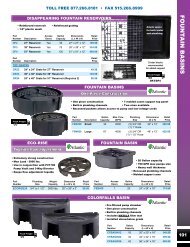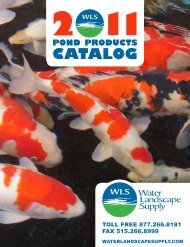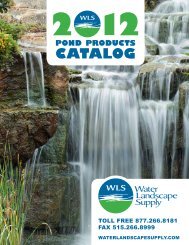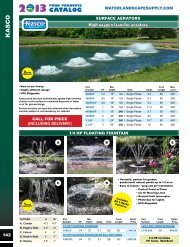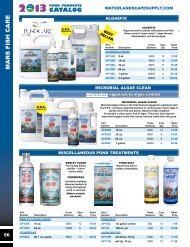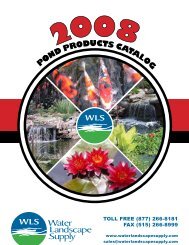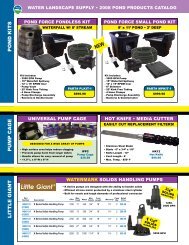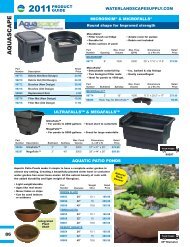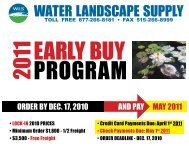lake management – aeratIon aIrmax - Water Landscape Supply
lake management – aeratIon aIrmax - Water Landscape Supply
lake management – aeratIon aIrmax - Water Landscape Supply
You also want an ePaper? Increase the reach of your titles
YUMPU automatically turns print PDFs into web optimized ePapers that Google loves.
pond tIps<br />
132<br />
algae In ponds<br />
In the most general terms, pond algae can be divided into two types:<br />
sIngle cell & strIng algae.<br />
sIngle cell algae<br />
microscopic single cell algae causes pond<br />
water to turn a pea soup, green color. they<br />
will appear when nutrients, sunlight, and<br />
water are present. they are so small that it<br />
is not possible to simply “filter” them out of<br />
pond water.<br />
metHods oF remoVal<br />
• Flocculants • UV Clarifiers<br />
• reduce food source • algaecide<br />
• Ben. bacteria & plants help by reducing<br />
nutrients needed for algae to survive<br />
nItrogen cycle In garden ponds<br />
FIsH can take care oF tHemselVes, IF pond-keepers take care oF water!<br />
8. aquatIc plants<br />
aBsorB nutrIents<br />
7. nItrogen gas<br />
released into<br />
atmosphere.<br />
6. nItrates<br />
strIng/FIlamentous algae<br />
string algae often appears in clear pond water.<br />
It attaches itself to rock in streambeds<br />
and waterfalls. also to sides of rocks inside<br />
pond. Blanketweed is another form of string<br />
algae. It rises to the surface of pond during<br />
heat of the day and sinks when water cools.<br />
metHods oF remoVal<br />
• products that remove organic debris<br />
• algaecide • pond Vacuum<br />
• Brush/twister<br />
1. FIsH waste & decomposIng deBrIs<br />
5. BeneFcIal<br />
BacterIa<br />
(nitrobacter sp.)<br />
2. ammonIa<br />
3. BeneFIcIal BacterIa<br />
(nitrosomonas sp.)<br />
4. nItrItes<br />
Bad water qualIty (ammonIa, nItrItes, & nItrates)<br />
Bad water quality through oVerstockIng, or Improper FIltratIon creates<br />
opportunistic environments for disease/pathogens to take their toll on fish in a pond.<br />
mecHanIcal FIltratIon<br />
when water is pumped through some type<br />
of filter material for the removal of suspended<br />
debris.<br />
Filter material in a pond is usually in two<br />
locations:<br />
• One is usually located in filter or filter falls<br />
• Second filter is setup to remove debris<br />
before water enters the pump<br />
These filter pads will need to be cleaned<br />
periodically to allow unrestricted flow of<br />
pond water. single cell algae is so small<br />
that removing it by mechanical filtration is<br />
not possible without the use of flocculants.<br />
• removes large, medium, small solids<br />
• commonly found in skimmers/falls<br />
• media • mats • Foam<br />
• Plastic • Pump pre-filters<br />
pHotologIcal FIltratIon<br />
Photological filtration or more commonly<br />
referred to as uV lights is a process in<br />
which water passes through & is exposed<br />
to ultraviolet light. exposure time or dwell<br />
time in conjunction to the wattage dictates<br />
the effectiveness of photological filtration.<br />
• uV lights<br />
• Clarifier [lower watts per flow (gph)]<br />
• Sterilizer [higher watts per flow (gph)]<br />
aquatic plants are an essential<br />
part of ponds & water gardens<br />
to balance the ecosystem.<br />
suggested plant coVerage:<br />
1/3 to 1/2 surface area coverage<br />
Increased plant load:<br />
yields increased oxygen (do) during<br />
the day, but too much plant load can<br />
cause oxygen deprivation at night.<br />
especially dangerous for ponds w/high<br />
fish & high plant loads.<br />
low plant load<br />
yields increased nitrates (fertilizer)<br />
which increases the likeness for algae.<br />
FIltratIon tIps<br />
plant tIps<br />
BIologIcal FIltratIon<br />
Beneficial bacteria colonizes on hard surfaces<br />
and water is pumped in and around that area.<br />
the bacteria helps break down ammonia and<br />
nitrites to less harmful nitrates. In some cases,<br />
denitrification occurs allowing nitrates to be<br />
broken down even further to nitrogen gas.<br />
this helps provide a healthier environment for<br />
fish. In addition, when nutrients are removed<br />
from a pond, it is more difficult for single cell<br />
algae to take over the pond. media used to<br />
colonize bacteria are usually cleaned only at<br />
the end of the season.<br />
Biological filtration occurs best when water is<br />
free of debris (after mechanical filtration).<br />
• Bacteria converts toxins to safer &<br />
usable substance (fertilizer)<br />
• waterfall box • canister<br />
• Bio-media: Balls, ribbons, shavings<br />
• Foam mats • plastic mats<br />
cHemIcal FIltratIon<br />
Chemical filtration utilizes phosphate binders,<br />
zeolite, or activated carbon to remove<br />
or bind impurities. In some cases ozone ionizers<br />
are used for oxidation & the “cleansing”<br />
process.<br />
water lIlIes:<br />
• tropicals (Fragrant)<br />
- day Blooming<br />
- night Blooming<br />
• Hardy<br />
Floaters:<br />
• water Hyacinth<br />
• water lettuce<br />
• azolla<br />
• duckweed<br />
• Frogbit<br />
• algaecides • zeolite<br />
• activated carbon • ozone Ionizers<br />
2009 www.waterlandscapesupply.com<br />
toll Free 877.266.8181 • Fax 515.266.8999<br />
lotuses:<br />
• traditional<br />
• miniature (“Bowl” lotuses)<br />
suBmerged (“oxygenators”):<br />
• anacharis<br />
• Hornwort<br />
• cabomba<br />
margInal (“bog” plants):<br />
• Hardy<br />
- cattail<br />
- Iris<br />
- Sweetflag<br />
• tropical<br />
- giant papyrus<br />
- umbrella palm<br />
- water canna<br />
pond tIps<br />
133



